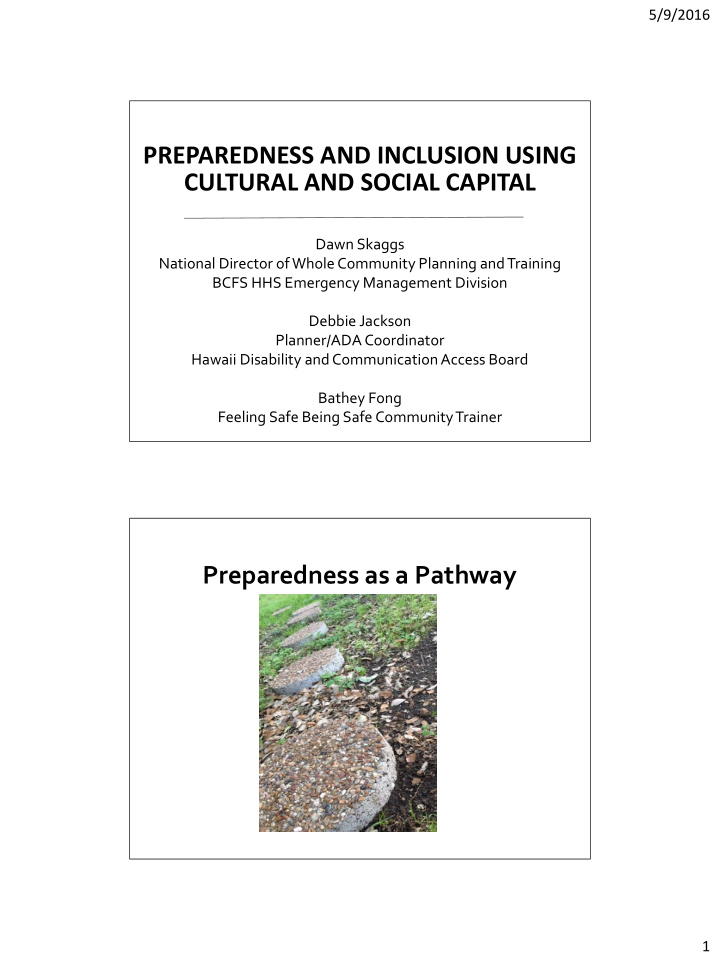



5/9/2016 PREPAREDNESS AND INCLUSION USING CULTURAL AND SOCIAL CAPITAL Dawn Skaggs National Director of Whole Community Planning and Training BCFS HHS Emergency Management Division Debbie Jackson Planner/ADA Coordinator Hawaii Disability and Communication Access Board Bathey Fong Feeling Safe Being Safe Community Trainer Preparedness as a Pathway 1
5/9/2016 Identifying Cultural and Social Capital Cultural Capital – Innovation 2
5/9/2016 Social Capital – Relationships Steps to Preparedness + Inclusion Personal Preparedness Process Planning Inclusion Process • Familiarity with threats and • Familiarity with planning process hazards • Identifying community needs and • Identifying needs and resources resources • Establishing natural supports • Building community relationships • Putting the pieces together • Engaging in the planning process • Practicing and sustaining • Formalizing roles and responsibilities and exercising 3
5/9/2016 Necessary Tools - Universal Accessibility • Plan • Supports • Information • Pathway Example Tool Disaster Volunteer Training http://www.bcfsemd.org/dvt 4
5/9/2016 DAWN SKAGGS, MA DAWN.SKAGGS@BCFS.NET 210-716-8700 WWW.BCFSEMD.ORG 2009 Interagency Action Plan for the Emergency Preparedness of People with Disabilities and Special Health Needs August 2009 5
5/9/2016 Co-Conveners • Hawaii State Department of Health • Hawaii Emergency Management Agency (HI-EMA, formerly State Civil Defense) • Disability and Communication Access Board (DCAB) Partners • County Civil Defense Agencies • State Agencies • Federal Emergency Management Agency (FEMA) • Service Providers and Community Agencies • Persons with Disabilities • Others with Access and Functional Needs 6
5/9/2016 Geographic & Cultural Uniqueness of Hawaii • Comprised of eight (8) populated islands • Surrounded by water in the middle of Pacific Ocean • Limited transportation between islands (by air & sea) • Diverse population and culture – no one ethnic majority • “Ohana” is part of the culture in Hawaii. The family is all inclusive with no one left behind Goals and Objectives of Plan • Sheltering • Emergency preparedness and readiness of people with disabilities and others with access and functional needs • Healthcare provider education • Accessible and redundant notification • Accessible transportation to/from shelters 7
5/9/2016 Outcomes and Accomplishments • Population of people with disabilities and others with access and functional needs identified in the community • Shelters being identified and assessed in the community • PWD & PAFN trained to have an emergency evacuation plan and kit Plan Updates Revisions to the plan will include: • Prevention and Mitigation • Response • Recovery • Education • Participating in Exercises 8
5/9/2016 Tips for Success • Identify, Invite, and include representatives to participate in planning effort, including individuals with disabilities and others with access and functional needs • Ensure meeting site is accessible for all participants • Provide accommodations for access to meetings • Agree to and assign goals and objectives to key agencies • Communicate by using everyday language • Collaborate by using existing resources • Acknowledge participants’ contributions For More Information Disability and Communication Access Board (808) 586-8121 debbra.jackson@doh.hawaii.gov health.hawaii.gov/dcab/ 9
5/9/2016 THE STORY OF BATHEY Hawaii Feeling Safe Being Safe Emergency Preparedness Trainer Community Educator Disabilities Advocate Subject Matter Expert Resource What My Life Was Like 1. I didn’t feel support. 2. I was put down. 3. I was a client. 4. I couldn’t speak up for myself. 5. I didn’t know that I could do a lot of things. 6. I didn’t know I could help other people. 10
5/9/2016 What I Did 1. I took an emergency preparedness class. 2. I took a training on how to be a trainer in emergency preparedness. I trained other how to be prepared. 3. I traveled to other islands to train people. 4. What I’ve Done and What I Do Now 1. I taught responders and emergency managers about Feeling Safe Being Safe and people with disabilities. 2. I helped other people become trainers. 3. I hosted a table at preparedness fairs. 11
5/9/2016 What I’ve Done and What I Do Now 4. I speak at conferences. 5. I participate in statewide exercises. 6. I work with Debbie, our ADA Coordinator. How What I Did Changed My Life I was shy, but worked on my confidence. 1. I learned how to speak up for myself. 2. I asked people to listen to me. 3. I learned how to share my feelings. 4. I learned how to not be scared and ask for 5. help. 12
5/9/2016 For People With Disabilities You need to: 1. Have respect for yourself. 2. Be more confident. 3. Use your voice and speak up for yourself. 4. Make your own choices and decisions. 5. Build relationships and choose the people in your circle of support. 6. Learn from your mistakes and be okay. Who I Am Today “I am the President for the Hawaii Self - Advocacy Advisory Council. I am a business owner training people about emergency preparedness. I help people with disabilities have a voice and make their own decisions. I dream of living on my own and having my own family. I want to travel and learn new things. I want to continue helping people reach their goals and dreams.” 13
5/9/2016 Dawn Skaggs 210-716-8700 Dawn.Skaggs@bcfs.net Debbie Jackson (808) 586-8121 debbra.jackson@doh.hawaii.gov Bathey Fong 14
Recommend
More recommend